RACE REPORT: RUSS JONES’ RACE ON THE BASE
Ron Saetermoe
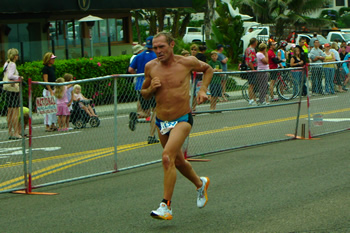 In 1986 Russ Jones weighed 145 pounds and was at the height of his athletic career. That year he took 2nd in the national duathlon championships, finishing second only to Mark Allen!
In 1986 Russ Jones weighed 145 pounds and was at the height of his athletic career. That year he took 2nd in the national duathlon championships, finishing second only to Mark Allen!
Fast-forward 24 years and Russ Jones is down to 145 pounds again but racing as one of the nation’s top 55 – 59 age group triathletes. He’s fit, he’s healthy and he’s going for his second #1 USAT ranking and national sprint triathlon and world triathlon age-group championships.
Several years ago, before his recent foot surgery, he was ranked #1 in the USAT standings above the likes of Joe Bonness and Kevin Moats – legends in their own right. He’s focused now and off to a great season.
One of the toughest things Russ has had to deal with this season is losing the extra 10 pounds he’s been carrying around since the holidays. We can all relate to that one. It’s been a real battle, even for a guy who’s used to battling.
The Race on the Base took place on February 27th at the Los Alamitos Joint Forces Training Base. It was going to be a tough day because of the weather.
The Race on the Base is a reverse triathlon, which means you run first, then bike then swim. This format is generally used when the swim takes place in a pool. As the field stretches out, the swim in the pool gets more manageable. Can you imagine starting 1,000 triathletes in a pool?
Anyway, Russ’ race was off to a good start. His 5K run time was 18:32, which is a 5:57 pace! Not bad for a 55 year-old dude!
He was feeling strong getting on to the bike and actually posted the fastest bike split (something he’s used to doing) for the 12-mile bike ride. 29:07, which is 24.73 miles per hour . . . in the pouring rain!
He figures he was 2nd overall after the bike portion of the race but got gobbled up by several younger, fishlike swimmers in the 200-yard swim and finished 6th overall and 1st in his age-group.
So the question is, “How does he do it?” I’ve been friends with Russ for several years now and can tell you he has no secrets – he’ll tell you exactly how he does it. If you’d like to learn more you can retain Russ to help you with your short-course training because he’s on his way to becoming a USAT certified coach himself.
His #1 secret? Less is more . . .
LEGENDS OF THE SPORT
Ron Saetermoe
I consider myself to be extremely lucky to have been coached by some of the legends of triathlon. And, my coaching goes on still. Yes, even coaches need coaching!
Among my coaches are Dave Scott, Mark Allen, Paul Huddle, Paul Newby Fraser, Michael Lovato, Jimmy Ricitello, Michael McCormack, Mike Collins, Kevin Koskella and John Howard. John who?
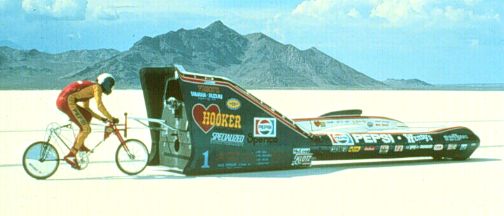
If you haven’t seen 50 candles on your birthday cake it’s quite conceivable that you don’t know the name John Howard. Let me fill you in on some of his accomplishments:
Competed in the 1968, 1972 and 1976 Olympic games
1971 won the gold medal at the Pan American Games
7.20.85 set the motor pacing speed record of 152 MPH on the Bonneville Salt Flats on a bicycle
1981 won the Ironman World Championship
Two years ago after I bought my new Cervelo P3C from Edge Cyclesports I went down to John’s house in San Diego to tweak the already great bike fit I got from Hank. John spent two hours with me, meticulously measuring and testing to make sure I could get as much power as possible. He’s a real pro.
So yesterday (Sunday, February 28th), I’m riding through downtown San Clemente on my way home from a 90-mile ride, and I see a white haired guy up ahead weaving all over the road trying to talk on his cell phone. (Not a good idea but something I have done myself.)
So I pass him and get stuck at the next light. He pulls up behind me but I don’t see his face. Same thing happens for another couple lights. Then all of a sudden this guy takes off downhill BETWEEN the moving cars and weaves in and out of traffic. I’m thinking that I’m about to see a guy get squashed!
Fortunately he gets stopped at another traffic light after his little stunt and I look over at him . . . it’s John Howard, and I say “There’s only one maniac out there that could have made that move!” We chatted for a minute and rode for a couple miles. He checked out my bike fit and as soon as he appeared, he was gone. He must have been motoring along at 35 MPH the last I saw of him.
This sport is great for so many reasons, not least of which are the really great, and approachable people we’ve got in it.
Cheers!
CHILLY SWIM ANYONE?
Ron Saetermoe
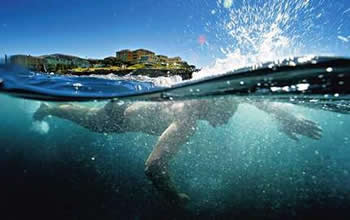
Well, the day is nearing . . . the day of the season’s first ocean swim (for me). It had to happen sometime and that day is getting closer.
Many of you reading this are competing in the California Ironman 70.3 on Saturday, March 27th. Chances are, most of you aren’t looking forward to the swim (myself included).
So, since misery loves company, I’d like to invite everyone (whether you’re doing the race or not) to join me in doing my first open water swim.
Date: Wednesday, March 17th
Time: 4:30 p.m.
Location: Big Corona
See you there!
Ron
RACE REPORT: TOUR DE PLAM SPRINGS, LY LY TA
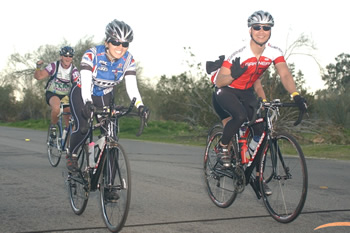 This “race” report is coming to you later than I had planned. I had no clue that recovery would take as long as it did.
This “race” report is coming to you later than I had planned. I had no clue that recovery would take as long as it did.
A little over a week ago, my husband and I found ourselves at the start line for the Tour de Palm Springs. We have never been to Palm Springs, and we have never participated in a ride of this sort. So, of course, we knew we had to give it a try despite the fact that his longest ride had been 30 miles recently and my longest was 55. But that didn’t matter. We had convinced ourselves this was not a race. We were going to have a good time!
The weather was absolutely perfect that day. There was some wind but it wasn’t bad at all. The sight of all the people and bikes at the start line was amazing. It was a first for me so I wanted to absorb all the energy to help me get through my first 100-mile ride.
I felt the first leg of the ride dragged on. I couldn’t believe how much time it took to get to the first SAG stop. There were a lot of people to navigate around before we settled at our pace. It took some time for me to warm up as well.
The climb was gradual but I could feel myself working hard. My goal was to go hard for the first half of the ride. I had not planned on stopping until after 50 miles. Unfortunately, it was nearly impossible to get through the first SAG stop without dismounting. The crowd was huge and there was no room to ride through.
Just a short stop and off we went. The second leg went by quickly. The downhill was great. We did see a rider taken away by ambulance so that was a reality check to stay alert. At this point, we had settled in with a larger group. I have never ridden in a pack so this was a little nerve wracking for me. I have been spoiled with all the trail rides in Orange County and the closed bike routes during the triathlon races. But, with 100 miles to practice, I eventually became comfortable!
Before I knew it, we passed the third SAG stop. I was doing well until about mile 35. I was feeling pretty tired at this point and decided to draft behind my husband. I still had more than half the ride to complete so I had to play it safe. After about 5 miles, I felt better and took the lead. Before I knew it, we were at the half way point. It couldn’t have come sooner. The road was getting rough right before the stop. Lunch was a nice spread of different sandwiches, Chex Mix, M&Ms. We ate very little despite the vast array of choices we had. I just didn’t know how my body would react to real food during a ride. I stuck with my Clif Bloks and Perpetuem, which worked out fine.
The last 50 miles flew by. I was enjoying the scenery and getter bolder on the road while my husband looked for excuses to get off the bike and rest. We stopped once so he could offer his bike pump to someone in need (there were a lot of flat tires on this course). After that little rest and a lot of chit chat, he got his second wind, and we were off. We got lost briefly following a group. We had just mentioned how lucky we were to be following people who knew where they were going. Once we were back on track, we decided we should glance at the map so we had a clue where to go. Up to that point, we weren’t really worried about the directions.
At last, we found ourselves heading for the finish line. We had exchange leads the entire way with many groups. In the end, a huge crowd of us seem to cross the finish together. It was very thrilling to accomplish a century for the first time! The energy of the crowd was amazing throughout the whole ride. I did not feel exhausted at all after the ride. In fact, I felt motivated to attempt another long ride in the near future. My body, however, told me I needed to give it some time to rest. And so I did for about a week!
SUPPORT YOUR LOCAL MERCHANTS
Ron Saetermoe
 A few weeks back I lamented about four local merchants that went under in this rough economy. This week I’m happy to report that a genuine institution in the triathlon world is actually expanding . . . our good friends at Edge Cyclesports.
A few weeks back I lamented about four local merchants that went under in this rough economy. This week I’m happy to report that a genuine institution in the triathlon world is actually expanding . . . our good friends at Edge Cyclesports.
Hank and Mary Ann at Edge are more than store proprietors, they’re merchants of speed! I bought my first Trek bike from Hank when I first moved to California. That bike is now in Jarrett’s garage and still has a few good miles left in it.
Since then I’ve bought two more bikes from Edge. A Kestrel and my Cervelo P3C (I no longer can blame my bike for my slow times).
I’m a huge believer in buying local. I can’t stand to see our local businesses going under and I often wonder if perhaps I’d just spent a little more money there (along with my friends) could we have saved them? I’m not sure, but I strongly encourage you to go to the new Edge Cyclesports opening Monday, March 1st.
Sure, you can probably buy most of the same stuff Edge sells online but whom are you supporting? The things the online merchants can’t do for you is give you the information and advice you need that may make your entire training and racing experience better.
When I walk into Edge I simply ask Hank to make me faster. Sometimes the response is just to “pedal harder” but sometimes it’s to change my set-up, replace my chain or to do nothing at all. I put all of my trust into Hank and the gang at Edge and I know lots of others that do too.
Go see Hank and Mary Ann at their new store (not far from the old one), and tell them Triathica sent you.
Edge Cyclesports
23561 Ridge Route, Suite J/K (new address)
Laguna Hills
949.472.9497
HAVE YOU READ THE TRIATHICA TRIATHLON ROADMAP?
Ron Saetermoe
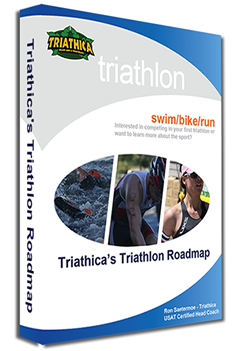
Were you aware that I wrote a book for beginner triathletes called the “Triathica Triathlon Roadmap” and that you can download it for free? That’s right; people that already subscribe to our weekly newsletter can download it for free!
We’re trying to increase our readership so please pass this link along to anyone else you know who is interested in triathlon. Triathica Triathlon Roadmap
Now, for those of you that have read the book I would appreciate it if you could take two minutes (literally) to drop me a line with what you thought about it. The reason is the more positive buzz we can create the more people will download it.
I will consider this a personal favor and will forever say good things about YOU!!!
Thanks!
Ron
FIVE REASONS YOU HAVEN’T TRIED A TRI
Jarrett Pflieger
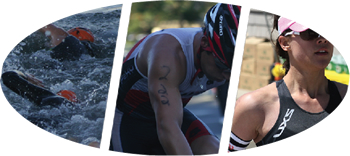
It is human nature to be scared of unfamiliar territory. We are all excellent at making excuses to keep ourselves from going out of our comfort zone and trying something new. These excuses could be keeping us from doing things that could change our lives for the better.
For many people, the idea of competing in a triathlon can be a scary thing. There are countless excuses not to try a triathlon, but even more reasons why you should. Here are some common excuses keeping people from venturing into the sport and why they may not be very good ones.
I don’t have enough time to train:
The average American spends an average of 127 hours watching television and 26 hours on the Internet per month. Even a quarter of this amount of time is more than enough to train for all three sports included in a triathlon. Depending on the distance you choose to race, you can easily get enough quality training with less than 10 hours a week.
Not to say that training for a triathlon isn’t a sacrifice, because many times you do have to give up some things, but a few less hours a week on Facebook and Twitter could make a world of difference. So turn off those reality TV shows and lace up your running shoes, in the end you will not regret it.
I’m not a (swimmer/cyclist/runner):
You do not have to already be good at all three sports, or any of them, to compete in a triathlon. Even world-class triathletes have weaknesses they must work on to even be competitive. It helps to come from a background in one of the three sports, but there are plenty of excellent triathletes that had no prior experience in any of the sports before doing their first triathlon. You may have to put in more time in one or two of the sports to get them up to par with the others, but a good coach and training plan can definitely get you there.
I’m too out of shape:
All the more reason to try a triathlon. There are people of all different ages, shapes, and sizes competing in triathlons. Anyone can do it if they start slow and build their fitness up one step at a time. If you go out too hard, too fast, you may get burned out before your body has time to catch up. Again, a good training plan and a coach can help you progress at a rate that is appropriate for your abilities.
I’m scared of not finishing:
Not finishing is always a possibility. Flat tires, crashes, and injuries have kept even the best triathletes from the finish line. There are certain things you can’t control, but one thing you can control is how you prepare. Put the time in, put your miles in, and you won’t have to worry about your fitness being what keeps you from finishing. Even if you don’t finish, you still did what 99% of people have never done. You stepped up to the starting line of a triathlon and gave it all you had.
I have no idea where to start
There are an infinite number of resources to help you start your triathlon journey. Check out websites like, www.triathica.com www.beginnertriathlete.com or many others dedicated to helping new athletes figure out what they need to do to succeed. There are thousands of books dedicated to the subject as well including Triathica’s Triathlon Roadmap as well.
You can also join your local triathlon club to find training partners, get advice, and ask questions. Find a certified triathlon coach to help you create a custom training plan based on your abilities and available training time. There is no shortage of information on how to start training for a triathlon if you know where to find it. So get out there and try something new. Even if you only do one race, it is something you carry with you forever.
PERIODIZING YOUR NUTRITION
Jarrett Pflieger
Successful triathletes know that periodizing their training is the key to getting the best results possible. Periodization is defined as the “progressive cycling of various aspects of a training program during a specific period of time.” When an athlete periodizes their training, they basically break down their training year into smaller cycles. Each cycle’s goal is different and works on a different aspect of a triathlete’s performance. One cycle may be to focus on longer and slower distances to increase endurance, while another cycle may focus on higher intensity efforts to raise an athlete’s lactate threshold and enable them to go faster while fatiguing less.
When an athlete changes up their training like this, their nutritional requirements also change. In order to get the most out of training, the foods you eat should change along with your training. How does this work?
Once we start thinking about food as fuel, it becomes clearer. When you are in your highest volume of training, your body needs extra fuel to give your body the energy it needs to get through your workouts. When in the offseason or a lower volume cycle, the goal should be eating clean foods and managing or losing any extra weight.
Many athletes make the mistake of trying to lose a few extra pounds before a race, but this is when you need to be keeping your body adequately fueled by eating more. The time to lose weight is not in the cycle leading up to the race, but much earlier during offseason or a low intensity cycle far out from your race.
Here are a few guidelines to help you periodize your nutrition along with your training:
– If you need to lose extra weight, stick with a high lean protein diet with lots of fruits and vegetables. Keep carbohydrate intake to a minimum. This should only be done far out from a race when training volume is low.
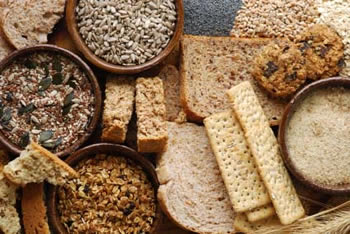 – When your training starts to increase during a build phase, begin to incorporate more whole grains and complex carbohydrates into your diet. Stick with whole wheat bread, brown rice, oatmeal, etc. Try to stay away from processed carbs, sugars, and fatty foods. Make sure to indulge every once in a while, but don’t overdo it.
– When your training starts to increase during a build phase, begin to incorporate more whole grains and complex carbohydrates into your diet. Stick with whole wheat bread, brown rice, oatmeal, etc. Try to stay away from processed carbs, sugars, and fatty foods. Make sure to indulge every once in a while, but don’t overdo it.
– During your race phase, make sure you are taking in plenty of complex carbs to fuel your intense workouts. This is not the time to go on a diet and limit your calories.
– Just listen to your body and increase caloric intake slowly to discourage rapid weight gain. If you are not hitting your goal times and have trouble completing longer distance workouts, you might not be eating enough. If you start gaining weight rapidly, you may be eating too much.
A certified dietitian can help you create a custom nutrition plan. If you need some help creating a periodized training plan, consult a certified triathlon coach. Get your nutrition plan on pace with your training plan and you will be surprised at what you can do.
RACE REPORT: SAN DIEGUITO HALF MARATHON
Ron Saetermoe
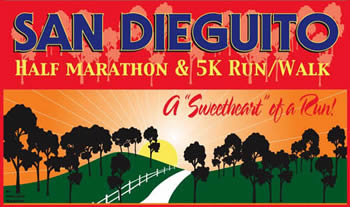
Until a couple weeks ago I’d never heard of the San Dieguito Half Marathon. That’s the problem with living in paradise – there are so many great options.
As you know, I’m into my Ironman training now, and as part of that I love the half marathon race distance. The distance really seems to help build speed and endurance without trashing you for a couple weeks.
San Dieguito is down in Rancho Santa Fe in San Diego County just east of Solana Beach. The area is beautiful with lots of trees and hills. Seven of us carpooled down there, which was fun in itself. Since we had a woman on board we were all on our best behavior (no farting!).
The weather was perfect and San Dieguito Park was beautiful. Truly a great place for a picnic if you’re looking to get away.
The race starts down the hill from San Dieguito Park and winds through the streets of Rancho Santa Fe, over the aforementioned hills. Hills at times that didn’t seem to have an end!
Scott (Scooter) Callender and Larry (Lar Dog) Davidson set the pace for our group. I started to run with Gary Clendenin but couldn’t hang with him.
At about mile two I saw Lar Dog off on the left side of the road working on his foot. He had a sharp pain in the top of his foot that forced him to stop. After about a minute he’d fixed the problem and promptly blew by me.
Shortly after that I passed Gary at one of the aid stations. I didn’t look back but thought he was just behind me. It wasn’t until later that I saw he’d dropped back a bit.
Since I loaded my legs from a 50+ mile bike ride the day before with Stu Lowndes into Huntington Beach I was hurting the entire way (RPE 10). There were opposing forces at work. My legs ached so they didn’t want to go fast but my heart rate was also up because I’d trashed myself the day before. Either way there wouldn’t be a PR in it for me today.
Everyone had a great time but Scooter absolutely killed this really tough course!
Scott Callender: 1:30:58 (6:57)
Larry Davidson: 1:33:55 (7:10)
Ron Saetermoe: 1:37:23 (7:26)
Kari Krause: 1:37:28 (7:27)
Gary Clendenin: 1:38:24 (7:31)
Sara Gilles: 1:39:43 (7:37)
Pete Kobrak: 1:41:42 (7:46)
Other notable racers:
Kate Major: 1:20:24 (6:08)
Michellie Jones: 1:22:18 (6:17)
Joanna Zeiger: 1:22:42 (6:19)
TAPER PERIOD
Ron Saetermoe
So your “A” race is over. You’re probably feeling good about your experience (if you prepared adequately) and are still hobbling around and nursing your blisters. Good for you!
What’s next? This is typically when many triathletes start getting depressed. All of the hard work is behind them and there is no immediate goal on the horizon. Wow! No mandatory 4:30 a.m. alarms and jumping into a freezing pool!
Your top priority now is to slack off! That’s right; take it easy for the next several weeks. Sleep in, eat some fast food and stay off your feet.
This period in your training is just as important as all of the other periods because you need to allow your body to heal from the constant pounding you’ve been giving it. Many triathletes worry about losing all of the hard-earned fitness during this period, and you will lose some, but it will come back.
My favorite activities when I’m in the taper period is swimming, easy bike rides and walking. All three will help you recover and won’t tax your body unnecessarily.
Enjoy these weeks. Plan your next season and just take it easy . . .
The key things about the Taper Period are:
– Any workouts should be directed toward recovery not fitness building
– Concentrate on low impact exercise with low intensity
– It’s okay to so some light resistance training
– Enjoy the taper . . . next season is just ahead!
Here’s what the ideal Triathica year looks like:

Again, we feel that three, three-week cycles within each period is optimal for building fitness and recovery. The time to build strength, speed and endurance is upon you. Make the best of it!
Cheers!
Ron


